CADILLAC ESCALADE 2022 Manual Online
Manufacturer: CADILLAC, Model Year: 2022, Model line: ESCALADE, Model: CADILLAC ESCALADE 2022Pages: 508, PDF Size: 9.18 MB
Page 81 of 508
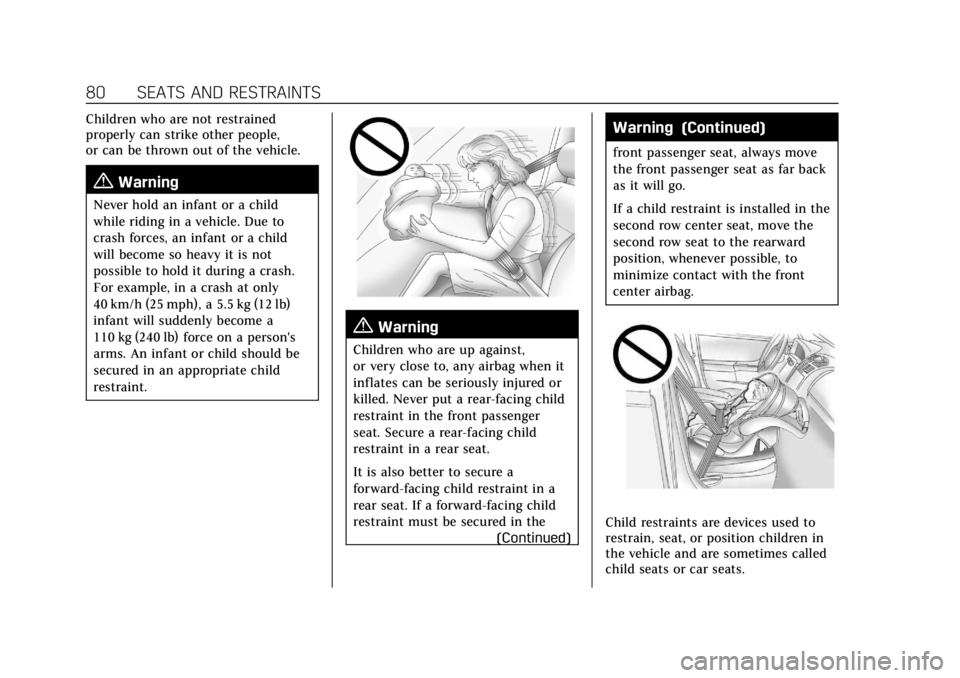
Cadillac Escalade Owner Manual (GMNA-Localizing-U.S./Canada/Mexico-
15567102) - 2022 - CRC - 11/17/21
80 SEATS AND RESTRAINTS
Children who are not restrained
properly can strike other people,
or can be thrown out of the vehicle.
{Warning
Never hold an infant or a child
while riding in a vehicle. Due to
crash forces, an infant or a child
will become so heavy it is not
possible to hold it during a crash.
For example, in a crash at only
40 km/h (25 mph), a 5.5 kg (12 lb)
infant will suddenly become a
110 kg (240 lb) force on a person's
arms. An infant or child should be
secured in an appropriate child
restraint.
{Warning
Children who are up against,
or very close to, any airbag when it
inflates can be seriously injured or
killed. Never put a rear-facing child
restraint in the front passenger
seat. Secure a rear-facing child
restraint in a rear seat.
It is also better to secure a
forward-facing child restraint in a
rear seat. If a forward-facing child
restraint must be secured in the(Continued)
Warning (Continued)
front passenger seat, always move
the front passenger seat as far back
as it will go.
If a child restraint is installed in the
second row center seat, move the
second row seat to the rearward
position, whenever possible, to
minimize contact with the front
center airbag.
Child restraints are devices used to
restrain, seat, or position children in
the vehicle and are sometimes called
child seats or car seats.
Page 82 of 508
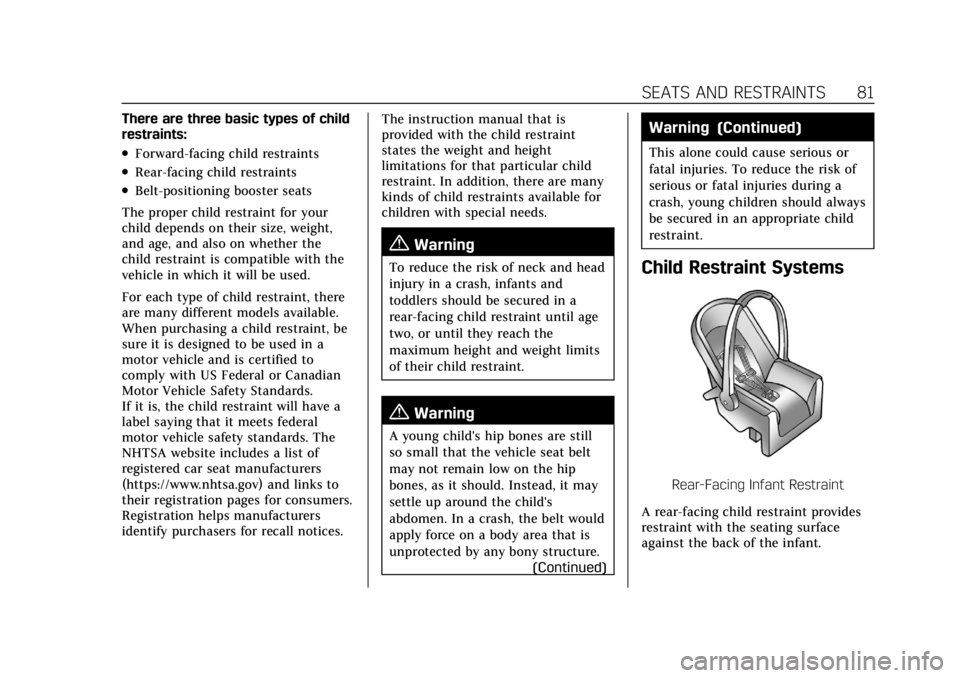
Cadillac Escalade Owner Manual (GMNA-Localizing-U.S./Canada/Mexico-
15567102) - 2022 - CRC - 11/17/21
SEATS AND RESTRAINTS 81
There are three basic types of child
restraints:
.Forward-facing child restraints
.Rear-facing child restraints
.Belt-positioning booster seats
The proper child restraint for your
child depends on their size, weight,
and age, and also on whether the
child restraint is compatible with the
vehicle in which it will be used.
For each type of child restraint, there
are many different models available.
When purchasing a child restraint, be
sure it is designed to be used in a
motor vehicle and is certified to
comply with US Federal or Canadian
Motor Vehicle Safety Standards.
If it is, the child restraint will have a
label saying that it meets federal
motor vehicle safety standards. The
NHTSA website includes a list of
registered car seat manufacturers
(https://www.nhtsa.gov) and links to
their registration pages for consumers.
Registration helps manufacturers
identify purchasers for recall notices. The instruction manual that is
provided with the child restraint
states the weight and height
limitations for that particular child
restraint. In addition, there are many
kinds of child restraints available for
children with special needs.
{Warning
To reduce the risk of neck and head
injury in a crash, infants and
toddlers should be secured in a
rear-facing child restraint until age
two, or until they reach the
maximum height and weight limits
of their child restraint.
{Warning
A young child's hip bones are still
so small that the vehicle seat belt
may not remain low on the hip
bones, as it should. Instead, it may
settle up around the child's
abdomen. In a crash, the belt would
apply force on a body area that is
unprotected by any bony structure.
(Continued)
Warning (Continued)
This alone could cause serious or
fatal injuries. To reduce the risk of
serious or fatal injuries during a
crash, young children should always
be secured in an appropriate child
restraint.
Child Restraint Systems
Rear-Facing Infant Restraint
A rear-facing child restraint provides
restraint with the seating surface
against the back of the infant.
Page 83 of 508
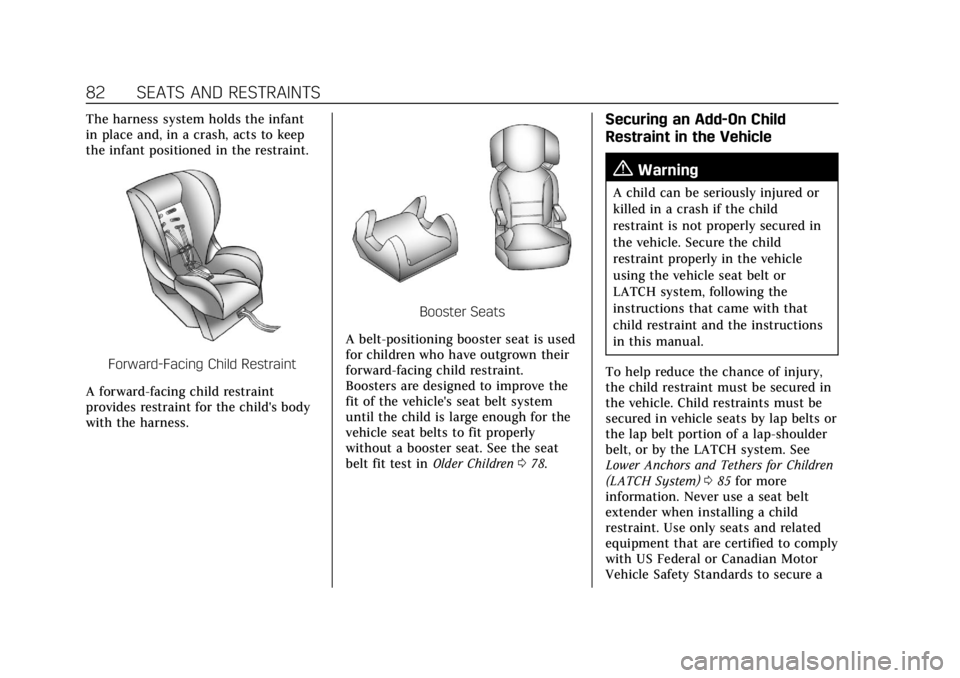
Cadillac Escalade Owner Manual (GMNA-Localizing-U.S./Canada/Mexico-
15567102) - 2022 - CRC - 11/17/21
82 SEATS AND RESTRAINTS
The harness system holds the infant
in place and, in a crash, acts to keep
the infant positioned in the restraint.
Forward-Facing Child Restraint
A forward-facing child restraint
provides restraint for the child's body
with the harness.
Booster Seats
A belt-positioning booster seat is used
for children who have outgrown their
forward-facing child restraint.
Boosters are designed to improve the
fit of the vehicle's seat belt system
until the child is large enough for the
vehicle seat belts to fit properly
without a booster seat. See the seat
belt fit test in Older Children078.
Securing an Add-On Child
Restraint in the Vehicle
{Warning
A child can be seriously injured or
killed in a crash if the child
restraint is not properly secured in
the vehicle. Secure the child
restraint properly in the vehicle
using the vehicle seat belt or
LATCH system, following the
instructions that came with that
child restraint and the instructions
in this manual.
To help reduce the chance of injury,
the child restraint must be secured in
the vehicle. Child restraints must be
secured in vehicle seats by lap belts or
the lap belt portion of a lap-shoulder
belt, or by the LATCH system. See
Lower Anchors and Tethers for Children
(LATCH System) 085 for more
information. Never use a seat belt
extender when installing a child
restraint. Use only seats and related
equipment that are certified to comply
with US Federal or Canadian Motor
Vehicle Safety Standards to secure a
Page 84 of 508
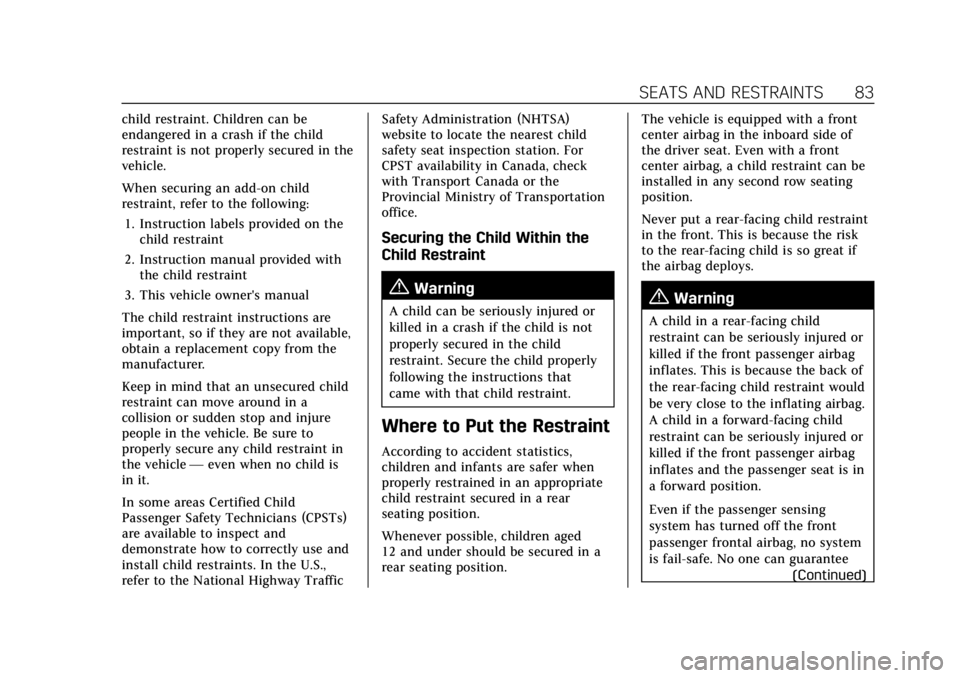
Cadillac Escalade Owner Manual (GMNA-Localizing-U.S./Canada/Mexico-
15567102) - 2022 - CRC - 11/17/21
SEATS AND RESTRAINTS 83
child restraint. Children can be
endangered in a crash if the child
restraint is not properly secured in the
vehicle.
When securing an add-on child
restraint, refer to the following:1. Instruction labels provided on the child restraint
2. Instruction manual provided with the child restraint
3. This vehicle owner's manual
The child restraint instructions are
important, so if they are not available,
obtain a replacement copy from the
manufacturer.
Keep in mind that an unsecured child
restraint can move around in a
collision or sudden stop and injure
people in the vehicle. Be sure to
properly secure any child restraint in
the vehicle —even when no child is
in it.
In some areas Certified Child
Passenger Safety Technicians (CPSTs)
are available to inspect and
demonstrate how to correctly use and
install child restraints. In the U.S.,
refer to the National Highway Traffic Safety Administration (NHTSA)
website to locate the nearest child
safety seat inspection station. For
CPST availability in Canada, check
with Transport Canada or the
Provincial Ministry of Transportation
office.
Securing the Child Within the
Child Restraint
{Warning
A child can be seriously injured or
killed in a crash if the child is not
properly secured in the child
restraint. Secure the child properly
following the instructions that
came with that child restraint.
Where to Put the Restraint
According to accident statistics,
children and infants are safer when
properly restrained in an appropriate
child restraint secured in a rear
seating position.
Whenever possible, children aged
12 and under should be secured in a
rear seating position.
The vehicle is equipped with a front
center airbag in the inboard side of
the driver seat. Even with a front
center airbag, a child restraint can be
installed in any second row seating
position.
Never put a rear-facing child restraint
in the front. This is because the risk
to the rear-facing child is so great if
the airbag deploys.
{Warning
A child in a rear-facing child
restraint can be seriously injured or
killed if the front passenger airbag
inflates. This is because the back of
the rear-facing child restraint would
be very close to the inflating airbag.
A child in a forward-facing child
restraint can be seriously injured or
killed if the front passenger airbag
inflates and the passenger seat is in
a forward position.
Even if the passenger sensing
system has turned off the front
passenger frontal airbag, no system
is fail-safe. No one can guarantee
(Continued)
Page 85 of 508
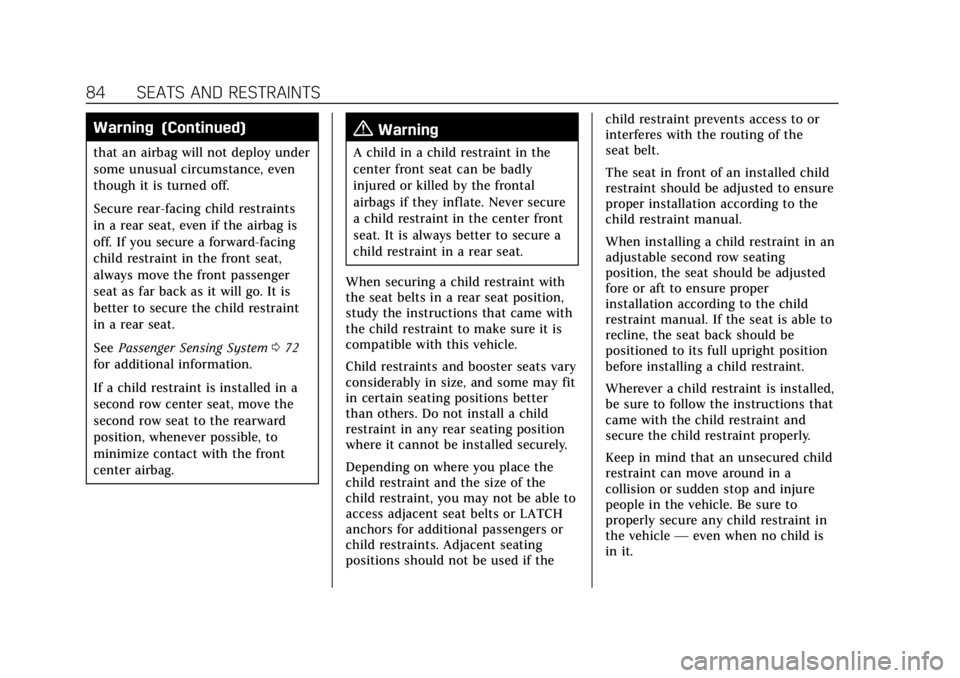
Cadillac Escalade Owner Manual (GMNA-Localizing-U.S./Canada/Mexico-
15567102) - 2022 - CRC - 11/17/21
84 SEATS AND RESTRAINTS
Warning (Continued)
that an airbag will not deploy under
some unusual circumstance, even
though it is turned off.
Secure rear-facing child restraints
in a rear seat, even if the airbag is
off. If you secure a forward-facing
child restraint in the front seat,
always move the front passenger
seat as far back as it will go. It is
better to secure the child restraint
in a rear seat.
SeePassenger Sensing System 072
for additional information.
If a child restraint is installed in a
second row center seat, move the
second row seat to the rearward
position, whenever possible, to
minimize contact with the front
center airbag.
{Warning
A child in a child restraint in the
center front seat can be badly
injured or killed by the frontal
airbags if they inflate. Never secure
a child restraint in the center front
seat. It is always better to secure a
child restraint in a rear seat.
When securing a child restraint with
the seat belts in a rear seat position,
study the instructions that came with
the child restraint to make sure it is
compatible with this vehicle.
Child restraints and booster seats vary
considerably in size, and some may fit
in certain seating positions better
than others. Do not install a child
restraint in any rear seating position
where it cannot be installed securely.
Depending on where you place the
child restraint and the size of the
child restraint, you may not be able to
access adjacent seat belts or LATCH
anchors for additional passengers or
child restraints. Adjacent seating
positions should not be used if the child restraint prevents access to or
interferes with the routing of the
seat belt.
The seat in front of an installed child
restraint should be adjusted to ensure
proper installation according to the
child restraint manual.
When installing a child restraint in an
adjustable second row seating
position, the seat should be adjusted
fore or aft to ensure proper
installation according to the child
restraint manual. If the seat is able to
recline, the seat back should be
positioned to its full upright position
before installing a child restraint.
Wherever a child restraint is installed,
be sure to follow the instructions that
came with the child restraint and
secure the child restraint properly.
Keep in mind that an unsecured child
restraint can move around in a
collision or sudden stop and injure
people in the vehicle. Be sure to
properly secure any child restraint in
the vehicle
—even when no child is
in it.
Page 86 of 508
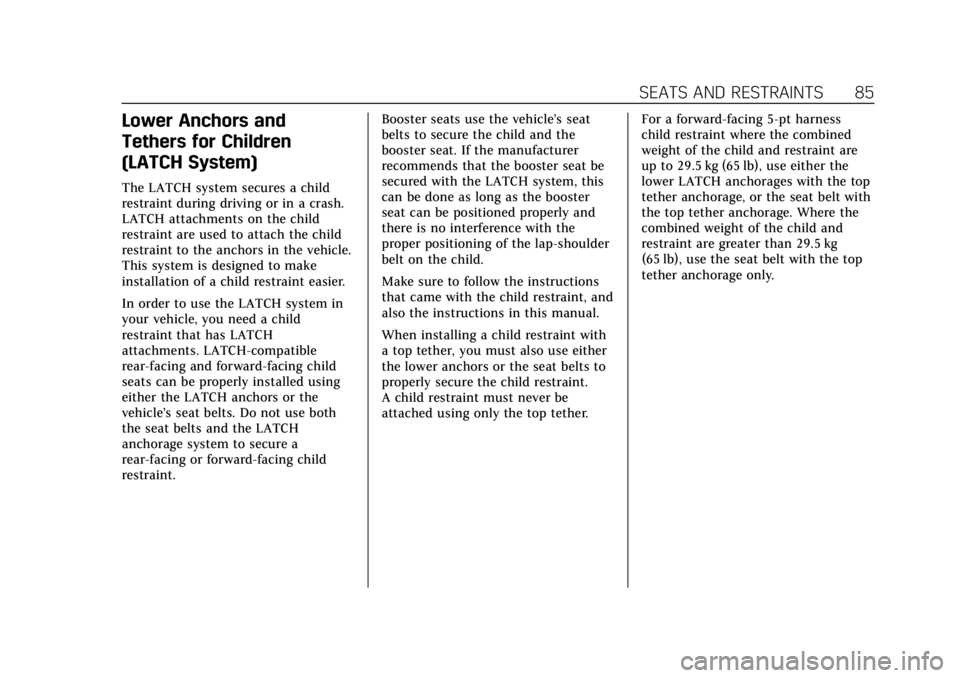
Cadillac Escalade Owner Manual (GMNA-Localizing-U.S./Canada/Mexico-
15567102) - 2022 - CRC - 11/17/21
SEATS AND RESTRAINTS 85
Lower Anchors and
Tethers for Children
(LATCH System)
The LATCH system secures a child
restraint during driving or in a crash.
LATCH attachments on the child
restraint are used to attach the child
restraint to the anchors in the vehicle.
This system is designed to make
installation of a child restraint easier.
In order to use the LATCH system in
your vehicle, you need a child
restraint that has LATCH
attachments. LATCH-compatible
rear-facing and forward-facing child
seats can be properly installed using
either the LATCH anchors or the
vehicle’s seat belts. Do not use both
the seat belts and the LATCH
anchorage system to secure a
rear-facing or forward-facing child
restraint.Booster seats use the vehicle’s seat
belts to secure the child and the
booster seat. If the manufacturer
recommends that the booster seat be
secured with the LATCH system, this
can be done as long as the booster
seat can be positioned properly and
there is no interference with the
proper positioning of the lap-shoulder
belt on the child.
Make sure to follow the instructions
that came with the child restraint, and
also the instructions in this manual.
When installing a child restraint with
a top tether, you must also use either
the lower anchors or the seat belts to
properly secure the child restraint.
A child restraint must never be
attached using only the top tether.
For a forward-facing 5-pt harness
child restraint where the combined
weight of the child and restraint are
up to 29.5 kg (65 lb), use either the
lower LATCH anchorages with the top
tether anchorage, or the seat belt with
the top tether anchorage. Where the
combined weight of the child and
restraint are greater than 29.5 kg
(65 lb), use the seat belt with the top
tether anchorage only.
Page 87 of 508
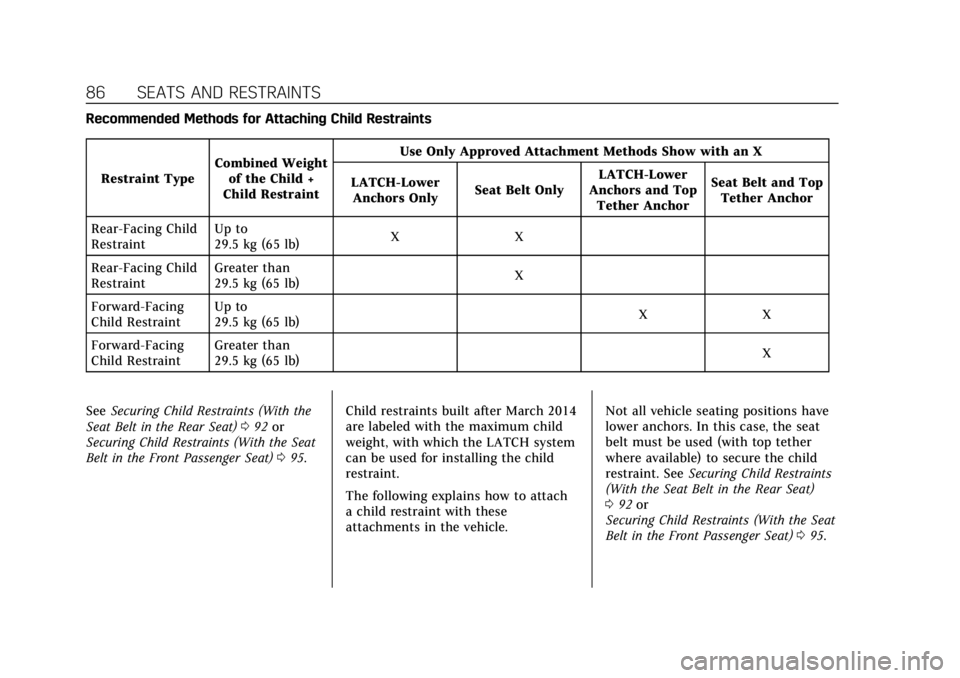
Cadillac Escalade Owner Manual (GMNA-Localizing-U.S./Canada/Mexico-
15567102) - 2022 - CRC - 11/17/21
86 SEATS AND RESTRAINTS
Recommended Methods for Attaching Child RestraintsRestraint Type Combined Weight
of the Child +
Child Restraint Use Only Approved Attachment Methods Show with an X
LATCH-Lower Anchors Only Seat Belt Only LATCH-Lower
Anchors and Top Tether Anchor Seat Belt and Top
Tether Anchor
Rear-Facing Child
Restraint Up to
29.5 kg (65 lb)
X X
Rear-Facing Child
Restraint Greater than
29.5 kg (65 lb)
X
Forward-Facing
Child Restraint Up to
29.5 kg (65 lb)
X X
Forward-Facing
Child Restraint Greater than
29.5 kg (65 lb)
X
See Securing Child Restraints (With the
Seat Belt in the Rear Seat) 092 or
Securing Child Restraints (With the Seat
Belt in the Front Passenger Seat) 095. Child restraints built after March 2014
are labeled with the maximum child
weight, with which the LATCH system
can be used for installing the child
restraint.
The following explains how to attach
a child restraint with these
attachments in the vehicle. Not all vehicle seating positions have
lower anchors. In this case, the seat
belt must be used (with top tether
where available) to secure the child
restraint. See
Securing Child Restraints
(With the Seat Belt in the Rear Seat)
0 92 or
Securing Child Restraints (With the Seat
Belt in the Front Passenger Seat) 095.
Page 88 of 508

Cadillac Escalade Owner Manual (GMNA-Localizing-U.S./Canada/Mexico-
15567102) - 2022 - CRC - 11/17/21
SEATS AND RESTRAINTS 87
Lower Anchors
Lower anchors (1) are metal bars built
into the vehicle. There are two lower
anchors for each LATCH seating
position that will accommodate a
child restraint with lower
attachments (2).
Top Tether Anchor
A top tether (3,4) is used to secure the
top of the child restraint to the
vehicle. A top tether anchor is built
into the vehicle. The top tether
attachment hook (2) on the child
restraint connects to the top tether
anchor in the vehicle in order to
reduce the forward movement and
rotation of the child restraint during
driving or in the event of a crash.
The child restraint may have a single
tether (3) or a dual tether (4). Either
will have a single attachment hook (2)
to secure the top tether to the anchor.Some child restraints with a top tether
are designed for use with or without
the top tether being attached. Others
require the top tether always to be
attached. In Canada, the law requires
that forward-facing child restraints
have a top tether, and that the tether
be attached. Be sure to read and
follow the instructions for your child
restraint.
Lower Anchor and Top Tether
Anchor Locations
Second Row
—60/40
H:Seating positions with two lower
anchors.
Page 89 of 508
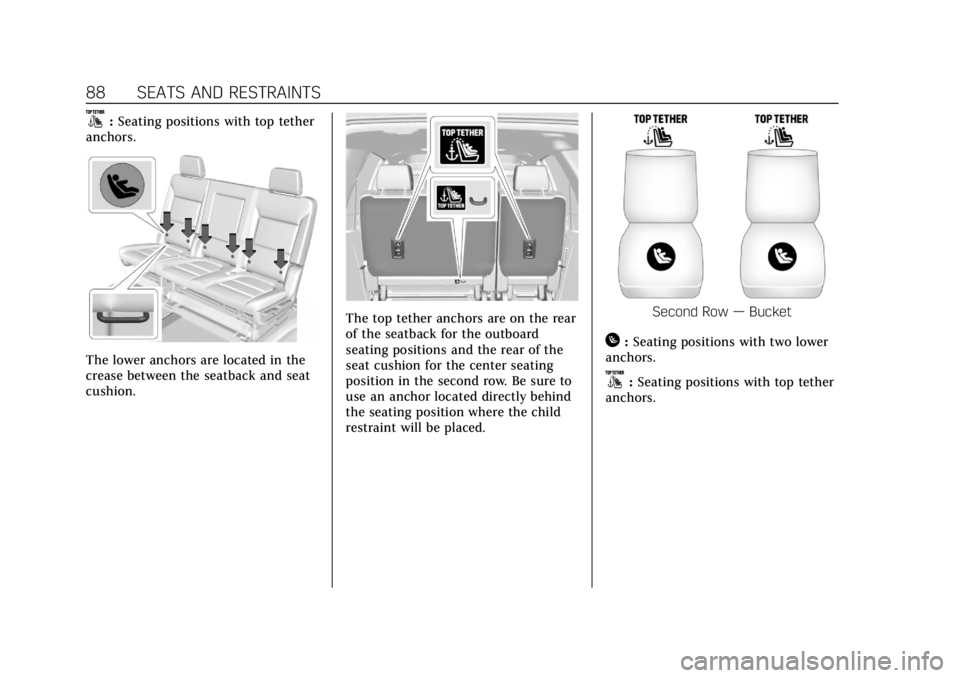
Cadillac Escalade Owner Manual (GMNA-Localizing-U.S./Canada/Mexico-
15567102) - 2022 - CRC - 11/17/21
88 SEATS AND RESTRAINTS
}:Seating positions with top tether
anchors.
The lower anchors are located in the
crease between the seatback and seat
cushion.
The top tether anchors are on the rear
of the seatback for the outboard
seating positions and the rear of the
seat cushion for the center seating
position in the second row. Be sure to
use an anchor located directly behind
the seating position where the child
restraint will be placed.Second Row —Bucket
H:Seating positions with two lower
anchors.
}: Seating positions with top tether
anchors.
Page 90 of 508

Cadillac Escalade Owner Manual (GMNA-Localizing-U.S./Canada/Mexico-
15567102) - 2022 - CRC - 11/17/21
SEATS AND RESTRAINTS 89
The lower anchors are located in the
crease between the seatback and seat
cushion.
For models with bucket second row
seating, the top tether anchors are on
the rear of the seatback for each
seating position in the second row. Be
sure to use an anchor located directly
behind the seating position where the
child restraint will be placed.
Third Row Seat
}:Seating positions with top tether
anchors.
For the third row seat, the top tether
anchors are on the back of the
seatback. Be sure to use an anchor
located directly behind the seating
position where the child restraint will
be placed.
Do not secure a child restraint in a
position without a top tether anchor if
a national or local law requires that
the top tether be attached, or if the
instructions that come with the child
restraint say that the top tether must
be attached.
According to accident statistics,
children and infants are safer when
properly restrained in a child restraint
system or infant restraint system